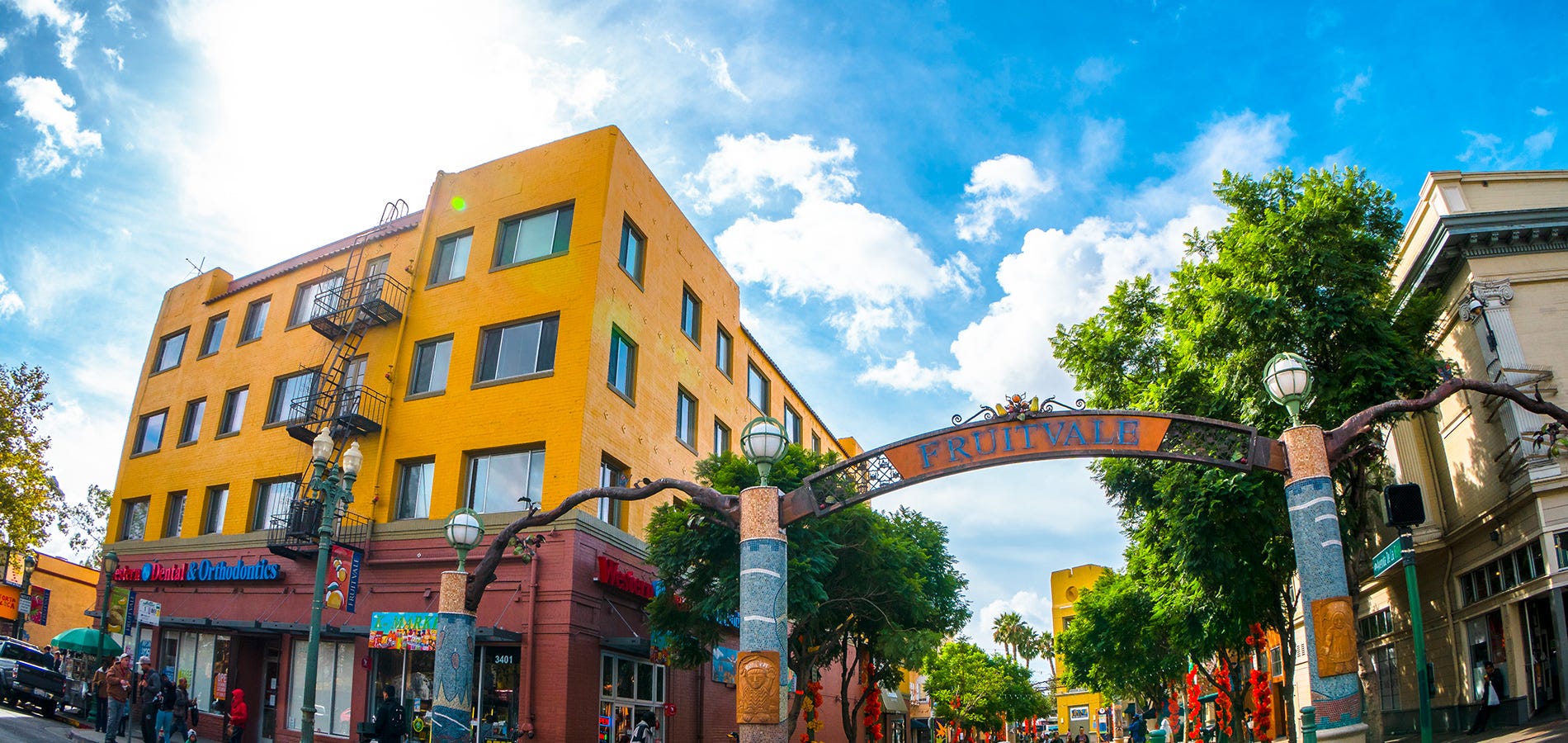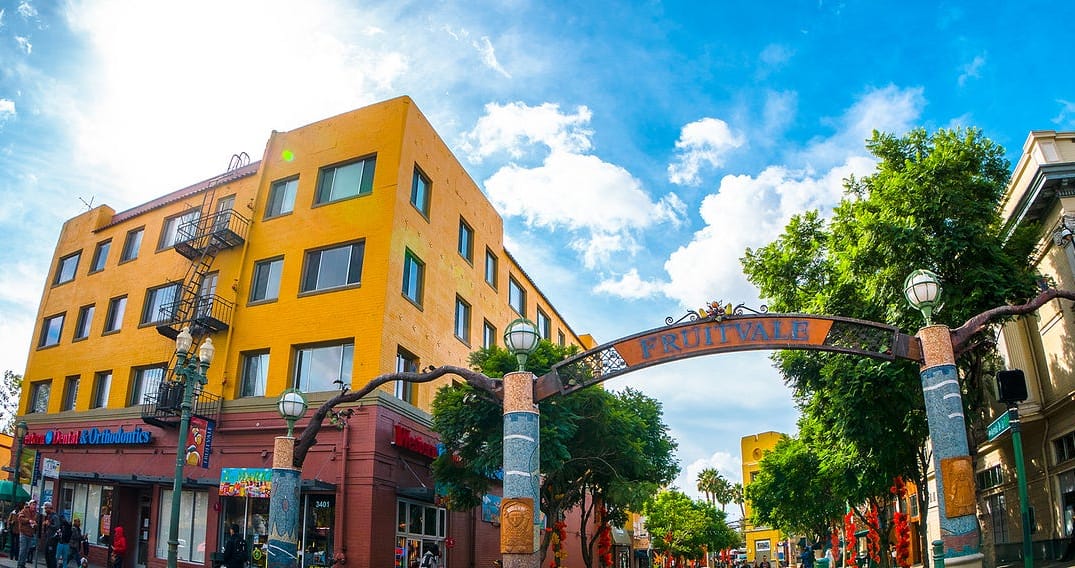
A metro or subway station may seem one-dimensional, a jumping-off point from one place to another. But some stations are destinations, drawing in visitors on the basis of their own merits. They may be architectural gems, like Grand Central Terminal in New York City or shopping meccas like Shinjuku in Tokyo. A few go beyond attaining this status and have become communities unto themselves.
Fruitvale Station is one such place. It’s a thriving transportation hub that also possesses the elements of a long-standing community.
I commute to the city from Fruitvale Station every day, witnessing this tangible sense of community up close. My daily journey here began in January 2009, just a few weeks after Oscar Grant was shot and killed by a BART police officer in the early hours of New Year’s Day. The tenth anniversary of the tragedy happened on January 1 of this year, marking a milestone that has largely defined the identity of the station.
Fruitvale ingests passengers not only from its namesake neighborhood but also from other areas of Oakland and adjacent towns — as evidenced by the busy AC Transit buses and the jam-packed parking. The ongoing stream of humanity begins in the early morning with commuters and school kids and continues until the last train departs for Warm Springs at 1:00 a.m.
The first clue that more is afoot than simply moving people is the Fruitvale Village sign that stands next to the station entrance. Fruitvale Village was developed in the early 2000s by the Unity Council, a nonprofit Oakland group, and became an early model of transit-oriented development.
The development is home to housing and multiple community organizations, including institutions that are hallmarks of any civic community: a health clinic, a public library branch and a school. It also features shops and restaurants, most of them locally owned, like neighborhood Mexican food fixture Obelisco (formerly the Taco Grill). In 2017, Reem’s, an Arab bakery, opened to much acclaim. Owner Reem Assil has been recognized by the James Beard Foundation and major food publications. Equally notable, Assil has made social justice a core value of her business by hiring local workers and providing a living wage.
Just beyond the official confines of the Village sits the Fruitvale Public Market. A small-business incubator also managed by the Unity Council, the Public Market is now home to Nyum Bai, a Cambodian restaurant that has made a national splash, earning a spot on Bon Appétit’s 2018 top-10 list of America’s Best New Restaurants. The goals of the restaurant’s owner, Stockton-raised Nite Yun, have been to promote Cambodian food and preserve traditional recipes that were nearly lost due to genocide.
Fruitvale Station also possesses a distinct history — and recent events reverberate.
North of the Village and Public Market, the overflow parking lot is adjacent to Guadalajara Restaurant — and importantly for commuters, its taco truck as well. The backside of Ale Industries brewery is the western edge of the lot. While these are not formally part of the station, they form an ecosystem that locals and commuters circulate through. If the circle were to be widened by just half a block, then much more would be in the station’s orbit, including a slice of the dense stretch of businesses along International Boulevard.
Excluding the Village apartments, Fruitvale Station itself has no official residents, of course. Some of its temporary denizens are from the surrounding neighborhoods (Fruitvale and Jingletown). Some follow established migration patterns—for example, commuters and students from Alameda’s East End. Some are occasional visitors passing through on their way to, say, a Warriors game or an event at the Coliseum. Finally, some are drawn to Fruitvale Village itself, which is a locus for community gatherings, like the regular farmers’ market and the annual Día de Los Muertos festival. At any given time, these disparate groups commingle and form a community.
Fruitvale Station also possesses a distinct history — and recent events reverberate. The film Fruitvale Station recounts the killing of 22-year-old Oscar Grant by a BART police officer on New Year’s Day in 2009.
The actor Michael B. Jordan, who plays Grant, described to the Los Angeles Times finding the bullet hole in the outbound platform where Grant was killed: “I remember putting my chest to the hole and being scared while I was shooting that scene.” As the director, Ryan Coogler, recounted, “There’s energy at that spot — people know it and what happened there. And oftentimes, people won’t stand at that end of the platform.”
The bullet hole has since been filled in. A mural of Grant’s image (on the outside of a private building) faces people waiting at the kiss-and-ride area. BART is planning a mural at the station itself (working with Grant’s mother, Wanda Johnson) to commemorate the tenth anniversary of Grant’s death. Grant’s family is also campaigning to rename the station as well as the short street in the bus-loading area. Grant’s uncle Cephus Johnson told the San Francisco Chronicle that after the mural is completed, the family plans to focus on this larger goal.
A second tragic event took place on December 2, 2016. A fire struck the building that housed the Ghost Ship art collective and resulted in the death of 36 people. For weeks after the disaster, riders looking out of the east-facing windows of trains could see the heartbreaking charred and empty edifice on 31st Avenue. Memorials bloomed around the building. Emergency vehicles and construction trucks occupied the BART lot and served as a reminder of the connection between the station and the neighborhood.
As the crowds exit, they leave by foot, bike, bus and car, and head to wherever home is.
While further along than other BART stations, Fruitvale is not alone in its tight embrace of its home neighborhood. The Mandela Gateway at West Oakland Station is another instance of transit-oriented housing. While not formally linked, the Embarcadero Station is close to both housing (the Gateway apartments) and shopping (the Embarcadero Center).
In recent years, BART has embraced more transit-oriented development. In 2017, 115 apartments were built on San Leandro BART property (with more to come), and passengers at the MacArthur BART station can see looming construction cranes at work on a huge 24-story apartment building.
These developments have some mixed-use elements, and they could blossom into communities. In August of this year, both the California State Senate and the California State Assembly passed versions of AB-2923, a law that gives BART the authority to build and manage housing on its properties. Indeed, BART has committed to building 20,000 units of housing and 4.5 million square feet of commercial space (including space for educational facilities) by 2040.
Whether these initiatives can retain a diverse population of residents like Fruitvale Village remains an open question. BART’s 2016 Transit-Oriented Development Policy set a goal to “serve households of all income levels,” and the agency aims to ensure that at least 35 percent of new housing is affordable. Some developments (like Marea Alta in San Leandro) are specifically built for low- and moderate-income renters.
Fruitvale Village itself is expanding, with new housing targeted for completion in the fall of 2019. This includes a renovation of a former Masonic temple on International Boulevard, which will be used as a community venue. The success of these system-wide efforts will be determined not only by BART but also the businesses that emerge at these locations.
Will these be local endeavors like Nyum Bai and Reem’s, which both grew out of San Francisco’s La Cocina food business incubator? Will they be focused on the host communities?
As the crowds exit, they leave by foot, bike, bus and car, and head to wherever home is—Fruitvale or Jingletown, neighboring communities in East Oakland, or Alameda across the estuary. The next time you’re passing through and hear the train operator say “Fruitvale Station” over the intercom, you’ll have a greater understanding of everything contained in the name.
Hey! The Bold Italic recently launched a podcast, This Is Your Life in Silicon Valley. Check out the full season or listen to the episode below featuring Aarti Shahani, technology reporter at NPR. More coming soon, so stay tuned!







